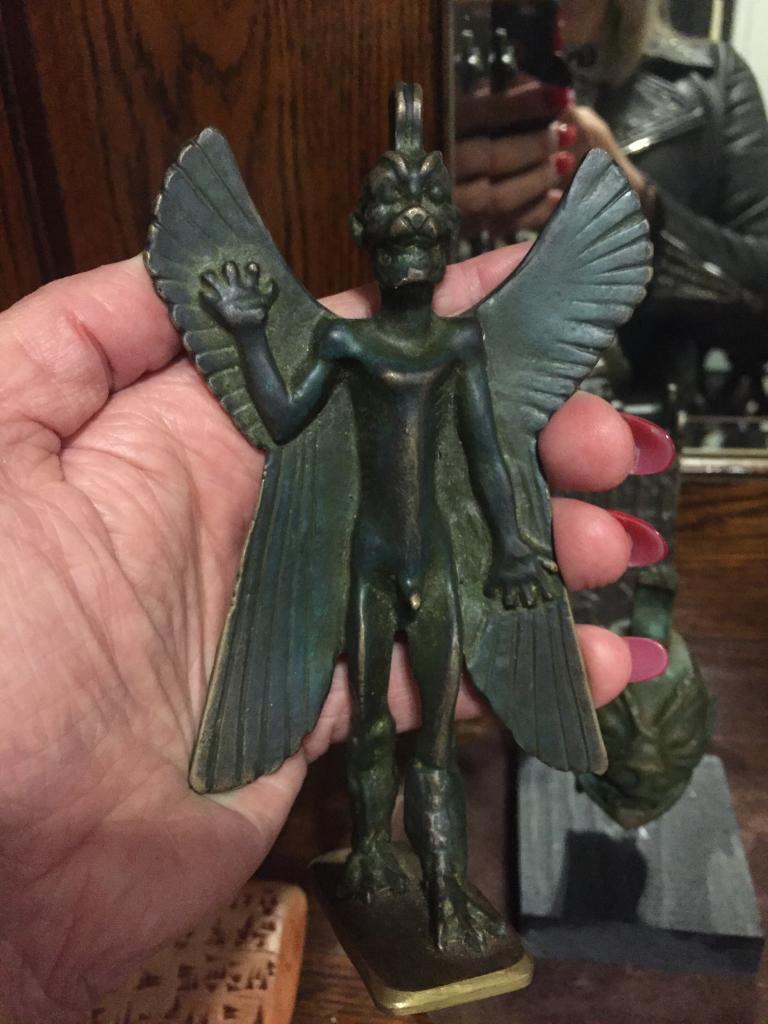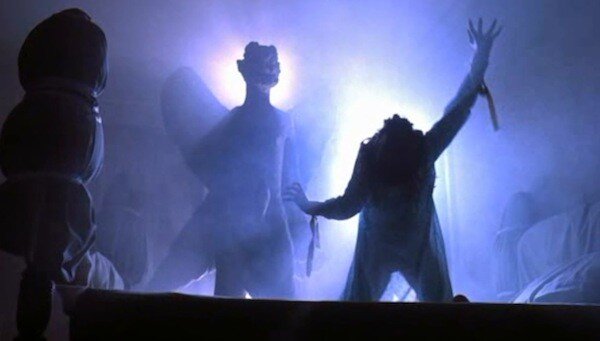Scene from the 1973 film The Exorcist
An early scene from The Exorcist shows a human-size Pazuzu statue on view at the site, and there is an uneasy expression on the face of the archaeologist-priest as he gazes at it. The camera lingers on the back-lit statue, as the noise of a nearby pack of dogs fighting provides an atmospheric soundtrack for the demon statue’s canine snarl. The scene has been set: Pazuzu appears as a foreign, ancient, violently malevolent source of evil power.
Who is the Demon Pazuzu?
I am Pazuzu, the son of Hanbu, king of the Lilu demons; I have scaled the powerful mountains; they trembled; the contrary winds were headed west; one by one, I broke their wings.
A demon of frightening form, who first appeared in the Neo-Assyrian period from 934–610 B.C., can be seen on a variety of protective amulets that people wore on their bodies or hung on the walls of their homes. He had a monstrous head resembling that of a fierce lion or dog with horns, an emaciated human body with clawed hands, a scorpion tail, and two sets of wings. His name was Pazuzu.
Pazuzu first appears in ancient Babylonian texts as the King of the Winds, with the purpose of protecting mankind from hardships, other demons, and the more vulnerable, such as pregnant women and children.
Pazuzu was married to Lamashtu. Stories about Lamashtu suggest she was responsible for illness and causing death to newborn babies, and children. Lamashtu is often depicted as a mythological hybrid, with a hairy body, a lioness’ head with donkey’s teeth and ears, long fingers and fingernails, and the feet of a bird with sharp talons. She is often shown standing or kneeling on a donkey, nursing a pig and a dog, and holding snakes. “She thus bears some functions and resemblance to the Mesopotamian demon Lilith.”
Lamashtu was a female demon, monster, malevolent goddess or demigoddess who menaced women during childbirth and, if possible, kidnapped children while they were breastfeeding. She would gnaw on their bones and suck their blood, as well as being charged with a number of other evil deeds. She was a daughter of the Sky God Anu
Pazuzu used his status to protect human life from demons such as his wife. Therefore, the statues and plaques of Pazuzu were not possessed evil objects, but were commonly used by the people of ancient times to protect their loved ones. You will soon learn many people adorned their homes and beds with the statues and plaques of Pazuzu, to scare away other demons and lower level entities. Pazuzu was the good guy!
Pazuzu for protection
Pazuzu is the demon of the southwest wind known for bringing famine during dry seasons, and locusts during rainy seasons. Pazuzu was invoked in apotropaic amulets, which combat the powers of his rival, the malicious goddess Lamashtu, who was believed to cause harm to mother and child during childbirth. Although Pazuzu is, himself, considered to be an evil spirit, he drives and frightens away other evil spirits, therefore protecting humans against plagues and misfortunes. (1)

Just let me say that I have a connection here in New Orleans, that has an original Pazuzu piece in his collection. He is a medical professional, a protector of human life, and finds great comfort and protection by having Pazuzu in his home, in the hospital where he works, and on his personal adornments.
Protection plaque against Lamashtu

The scene in the plaque shows Pazuzu protecting the patient during the exorcism ritual/medical procedure.
From the Louve website.
The exorcism scene is divided into registers.
In the upper register, symbols represent the great cosmic gods that are invoked to heal the sick person: the sun of Shamash, the crescent moon of Sin, the lightning bolt of the storm god Adad, and the winged disc of Ashur, the supreme god of the Assyrian Empire.
The seven spirits in the second register, each with a different animal’s head, probably have a beneficial function: they seem to be symbolically guarding the door of the patient’s bedchamber.
The patient is in the third register, lying on a high bed surrounded by two figures dressed in fish skins like the spirits associated with Ea, god of the depths and wisdom. They are probably the priestly exorcists who are conducting the ritual, with the help of three animal-headed spirits.
The causes of the illness appear in the lower register. Lamashtu, sitting on a donkey in a boat, is twice as big as all the other characters. She is presented as physically fearsome, with a hairy body, lion’s head, and talons. She is holding snakes and suckling two lion cubs. An inscription describes her as “furious and cruel, a dazzling goddess; she is a she-wolf; she snatches the young man on the path, the girl at play, the child from the arms of his nurse.” The boat is sailing along a river full of fish, which symbolizes the world of Apsu – the underworld that is home to demons. The gifts and provisions at the side of the scene are meant to encourage her to set off on her journey back to the underworld.
Pazuzu is standing behind Lamashtu, with one arm raised. Even though his gesture may seem threatening and, with his scaly winged body, dragon’s head, scorpion’s tail, and talons, he is physically as fearsome as his spouse, he is nonetheless there to protect the patient by coaxing his wife to retreat.
Pazuzu is again seen looming up above the scene clinging on to the back of the plaque.
Documents and objects that give protection from Lamashtu’s evil doings were widespread in the 1st millennium in Mesopotamia, a period in which this type of belief seems to have flourished.
Asking Pazuzu to Protect You
Pazuzu’s presence on amulets shows that his fearful strength could be used to keep away other harmful demons and serve as a guardian of your home. Pazuzu could also offer you protection against other evil spirits. He can also be summoned to banish evil spirits attached to you or your home.
The easiest way to connect with this demon Pazuzu is to set up an altar space in your home with an image of the demon placed center on the altar.
Traditional incense, such as frankincense or myrrh, could be burnt as an offering. If you know how to use a scrying mirror, it would make sense to have the scrying mirror on the altar as well. But if you can’t use a scrying mirror, then don’t bother because it will just provide a source of frustration and distraction. I would set two candles on either side of Pazuzu, probably both Black, but if you’re practicing satanic magic, you would use one black and one white.
Pazuzu was approached with offerings and could be accessed by spells performed in prescribed ways. As with many demons of this time, you can entice them with red wine. The time to leave the red wine on the altar is after you make your request. And just for the sake of completion, you would leave the red wine on the altar for a few days at least. And if you are consistently working with Pazuzu you would make sure the red wine offering never runs dry.
TIP – An additional tip would be to add a drop of your blood to the wine. This is very powerful and will connect you strongly to the demon. However, if you’re not accustomed to the demonic energy, this may be too overwhelming for you. It’s important that you visualize your reaction should the demon appear virtually before you. Remember that you were summoning a demon, and if you freak out at its presence, it would be quite disrespectful.
Suggested incantation (found on his amulets) commands the evil demons to keep away from the house he protects.
Agony of mankind, disease of mankind, suffering of mankind, do not enter the house I enter, do not come near the house I come near, do not approach the house I approach!
A more modern request could be,
“Mighty Pazuzu, I stand before you, a humble seeker, I beseech your protection from the darkness that threatens me, In exchange for your assistance, I offer you this wine, May its essence please you and strengthen our binding.”(7)
During this time, you can spend time in meditation, focused on the connection with the demon, and with what you desire as an outcome of having Pazuzu in your life. At the close of your ritual, you may say something like the following:
“Pazuzu, I am grateful for your aid, With your protection, I am unafraid, I release you now, go in peace, And let this connection gently cease.”
It’s now your choice, whether you close out the ritual by blowing out the candles, or let the candles burn as an additional offering.
Did Pazuzu possess Regan in the exorcist movie?
Pazuzu was portrayed as the demon responsible for human possession and devastating mayhem in all of the Exorcist franchise movies. An alternative theory as to why Pazuzu was seen as the possessing demon in the child Regan…..
“(Pazuzu was the )….protector of the vulnerable and the innocent…. that he is possessing Regan only after another entity or entities had gotten there first……. what if he was actually in there to drive out the other demons and protect someone who wasn’t strong enough to protect herself……)”
Did Pazuzu force the demons from young Regan’s body, and not the failed exorcisms by the two priests?
Rather than a demon who viciously possessed defenseless humans, as in The Exorcist, Pazuzu was actually a powerful defense against demonic attacks from Lamashtu. In the movie, his frightening appearance was enough to make him a plausible enemy, but in his original context, Pazuzu’s identity was far more complicated, and more interesting, than as one side in a simple opposition between good and evil.
As always, I suggest that you do your own investigations into the demon’s history and purpose. As practitioners in the dark arts who work with demons, one will soon discover a unique purpose for each “demon” and not all “demons” are guilty of harming humans.
If you have had an experience working with Pazuzu, I would love to hear about this experience – good, bad, or other. Likewise, share your thoughts on Pazuzu, The Exorcist movie, or demon portrayal.
Savannah
First Published on: Feb 26, 2018
References:
- https://en.wikipedia.org/wiki/Pazuzu
- Plaque for protection against the female demon Lamashtu- https://www.louvre.fr/en/oeuvre-notices/plaque-protection-against-female-demon-lamashtu
- Wiki – https://commons.wikimedia.org/wiki/File:Lamashtu_plaque_9167.jpg
- https://en.wikipedia.org/wiki/Ancient_Mesopotamian_religion
- Image – A seen from the exorcist movie – http://amzn.to/2EUo14Y
- https://www.metmuseum.org/exhibitions/listings/2014/assyria-to-iberia/blog/posts/pazuzu
- https://occultist.net/how-to-summon-pazuzu-ritual/


well no experiance with pazuzu. but lamashtu i have have a breif experience with flew over my house a few times wings you can hear without clairaudience